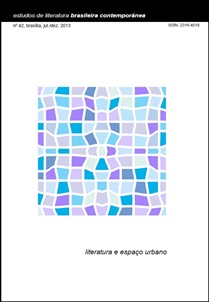Quando a linguagem é imprescindível à sobrevivência:
Ó, de Nuno Ramos
DOI:
https://doi.org/10.1590/S2316-40182013000200016Abstract
Desenvolvendo tema tão privilegiado pela literatura quanto o da orgânica relação entre corpo e linguagem, o romance Ó, de Nuno Ramos, tangencia os limites entre escrita do corpo e escrita da morte a partir de uma crise da linguagem desencadeada pela degenerescência do corpo. A crise provoca um estranhamento entre subjetividade e corpo, identidade e linguagem que, em consequência, instaura uma escrita da deriva. A dimensão da deriva passa a ser encenada por meio da articulação entre a tradição literária e a fratura causada na linguagem pelo contato com o residual. Nesse movimento, a obra de Nuno Ramos abandona a noção tradicional de realismo e representação em nome da teatralização dessa mesma tradição e da própria escrita. Seguindo estes caminhos de reflexão, buscarei retratar os aspectos abordados pela obra de Nuno Ramos dentro de uma perspectiva da literatura brasileira contemporânea que ressignifica questões de fundo problematizadas pela tradição literária brasileira e por precursores da estética contemporânea, como Clarice Lispector.
References
BATAILLE, Georges (1967). A parte maldita. Rio de Janeiro: Imago.
D’ANGELO, Biagio (2011). Ó, o lugar da negatividade. In: Novas leituras da ficção brasileira no século XXI. São Paulo: Mackenzie.
DELEUZE, Gilles; GUATTARI, Félix (2003). Kafka. Para uma literatura menor. 1. ed. Lisboa: Assírio e Alvim.
DIAS, Ângela (2011). Nuno Ramos e suas torres de babel: o criador como tradutor. In: Tradução literária: a vertigem do próximo. 1. ed. Rio de Janeiro: Beco do Azougue.
KIFFER, Ana (2010). Entre o Ó e o “Tato”. Alea: Estudos Neolatinos, v. 12, n. 1, p. 34-46.
LISPECTOR, Clarice (1978). Água viva. 3. ed. Rio de Janeiro: Nova Fronteira.
________ (1979). A paixão segundo G.H. 6. ed. Rio de Janeiro: Nova Fronteira.
RAMOS, Nuno. Ó. São Paulo: Iluminuras.
Downloads
Published
Issue
Section
License
Authors who publish in this journal agree to the following terms:
a) The authors maintain the copyright and grant the journal the right of first publication, the work being simultaneously licensed under the Creative Commons Attribution License-Non Commercial 4.0 which allows the sharing of the work with acknowledgment of the authorship of the work and publication this journal.
b) Authors are authorized to enter into additional contracts separately, for non-exclusive distribution of the version of the work published in this journal (eg publish in institutional repository or as a book chapter), with authorship recognition and publication in this journal.
c) Authors are allowed and encouraged to publish and distribute their work online (eg in institutional repositories or on their personal page) after the editorial process, as this can generate productive changes, as well as increase the impact and citation of published work (See The Effect of Free Access).
d) The authors of the approved works authorize the magazine to, after publication, transfer its content for reproduction in content crawlers, virtual libraries and the like.
e) The authors assume that the texts submitted to the publication are of their original creation, being fully responsible for their content in the event of possible opposition by third parties.


